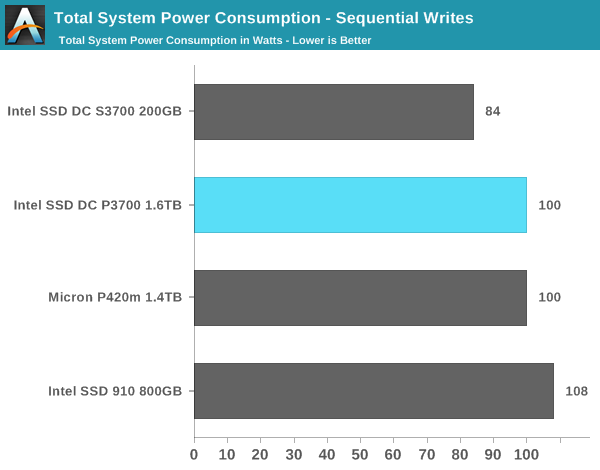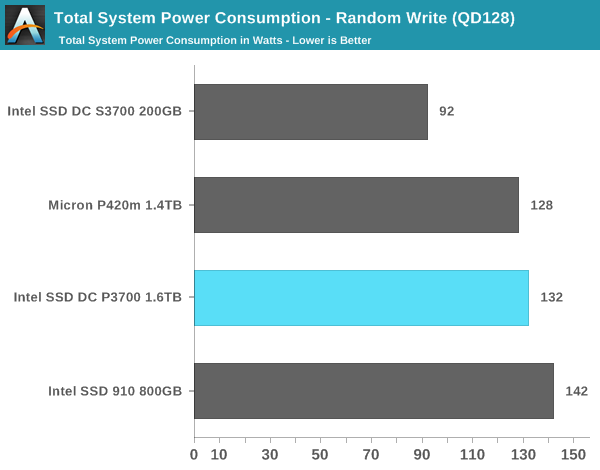Intel SSD DC P3700 Review: The PCIe SSD Transition Begins with NVMe
by Anand Lal Shimpi on June 3, 2014 2:00 AM EST- Posted in
- Storage
- SSDs
- Intel
- Intel SSD DC P3700
- NVMe
Power Consumption
To quantify power consumption we're looking at total system power, which takes into account the CPU load associated with workload generation as well as the power drawn by the drive itself. The P3700 was left in its default lower power operating mode, not the higher 25W mode.
Overall the P3700 doesn't raise any power consumption flags. The overall system power consumption ends up being around 16W higher than with a single S3700, but if you normalize for performance the two end up looking quite similar. There seems to be some power savings compared to the old Intel SSD 910, and roughly comparable power consumption to the P420m.












85 Comments
View All Comments
extide - Tuesday, June 3, 2014 - link
They finally did it, a bad ass no-compromises SSD.extide - Tuesday, June 3, 2014 - link
Dissappointed you didnt run the 2013 Destroyer on there, with that amazing low-queue depth performance, it will probably blow everything else away on that chart.smartypnt4 - Tuesday, June 3, 2014 - link
I mean really... For $1.50/GB, this could be purchased by a desktop enthusiast, so it's completely valid to test this against other consumer drives to see how it'd do. I'd be very interested in the results.B3an - Tuesday, June 3, 2014 - link
I agree, needs consumer drive comparisons...edward1987 - Tuesday, February 7, 2017 - link
I found some better use for this pcie ssd drive. You can use it in qnap TVS-1282 or TDS-16489U for hot data. They do tiered storage functionality. Its £600 to get this ssd, but if you want VMs this is great. (https://www.span.com/product/Intel-SSD-DC-P3700-PC...TelstarTOS - Tuesday, June 3, 2014 - link
absolutely, but wait until they have a 3600 or 3500 in their hands.NCM - Tuesday, June 3, 2014 - link
It would also be useful to compare to the PCIe consumer SSD's that Apple has been shipping in the MacBook Pro, MacBook Air and iMac lines for quite some time now. Given its sales volume and early adoption of PCIe drives, I'd have to imagine that Apple may have shipped more of them to users than anyone else. (These drives are supplied by both Samsung and SanDisk, and perhaps others.)Yes this new Intel product is for a quite different market, but comparison is how one comes to understand what those differences are and mean.
Marthisdil - Tuesday, June 3, 2014 - link
No one really cares much about Apple's offerings. Mainly because they are such a small percentage of the Marketplace....easp - Monday, June 9, 2014 - link
You miss the point. They are one of the largest players in the consumer market. Moreover, most of their sales are a premium price points and include SSDs. Put the two together, and they almost certainly ship more consumer SSDs than any one else by far. What's more, many of their lines are already on PCIe SSDs.So, please explain why Apple's shipping PCIe SSD options aren't a significant point of comparison against an aftermarket SSD that just arrived in the market.
SeanJ76 - Wednesday, May 20, 2015 - link
Casue Apple is shit!